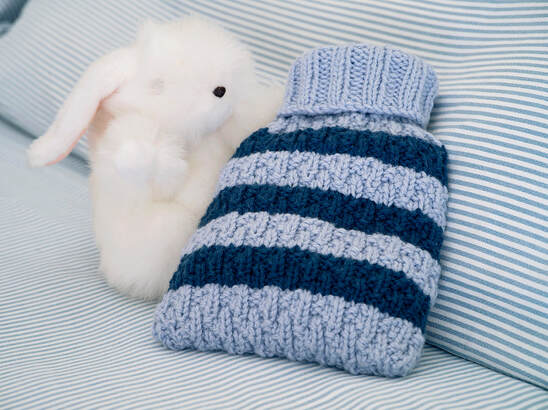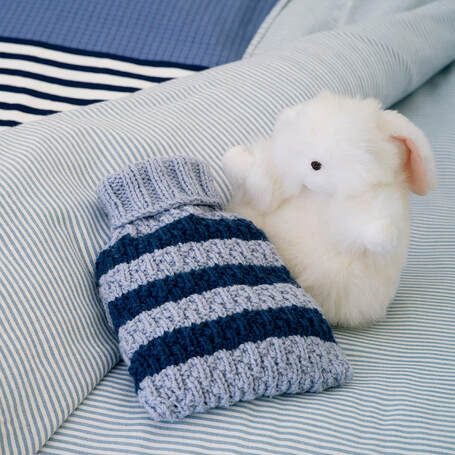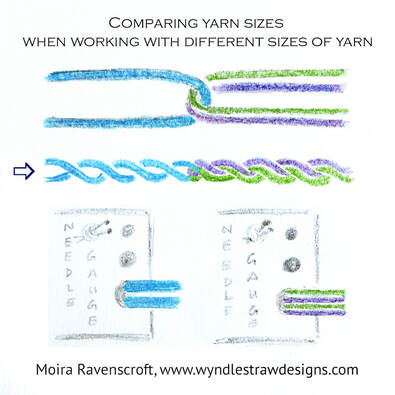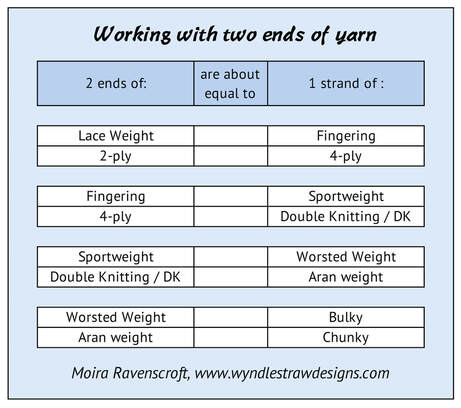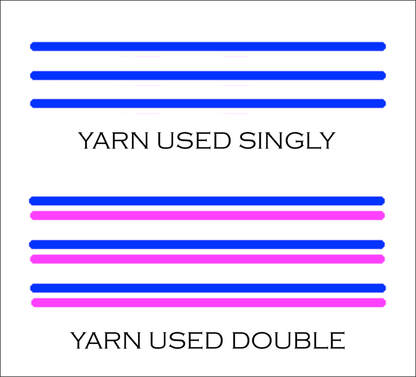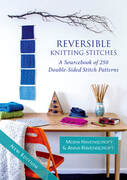I suppose I must be a creature of habit because I used the same title for a blogpost back in 2014! At that time I was referring to adding extra sizes to the Beckenham Scarf knitting pattern. However, this time I am thinking about options for choosing yarn. It really is good to have alternative strategies when you go to your yarn store or dive into your stash to find the perfect yarn for your next project.
I mentioned this in my last blogpost when I was talking about a shawl I was making. I couldn't find the perfect weight of wool in my local yarn store but they had the exact colours I wanted in a thinner yarn. Working with two ends of this yarn held together gave me exactly what I wanted – and more besides, as the shawl ended up being much warmer than I had anticipated!
So in this third blogpost in the "Seeing Double" series, I would like to explore how we can put two or more ends of yarn together to expand our yarn choices.
I mentioned this in my last blogpost when I was talking about a shawl I was making. I couldn't find the perfect weight of wool in my local yarn store but they had the exact colours I wanted in a thinner yarn. Working with two ends of this yarn held together gave me exactly what I wanted – and more besides, as the shawl ended up being much warmer than I had anticipated!
So in this third blogpost in the "Seeing Double" series, I would like to explore how we can put two or more ends of yarn together to expand our yarn choices.
As an example, here is a stripey hot water bottle cover that I have just finished. This is the small-sized cover from the Joules & Joulietta Hot Water Bottle Cover pattern. The pattern actually uses just a single colour in a Worsted weight but I was keen to use up some of my stash yarns and make a striped version.
The dark blue colour was a remnant of Worsted weight hand-spun yarn from my Ocean Currents Rug which I made over 10 years ago! However, I didn't have a good combination colour in the same weight.
So, I decided to look at thinner yarns and found a lovely soft lilac-blue sportweight yarn which gave a perfect colour combination. The next question was: would this be a good match for the thicker yarn if I used it doubled up? Fortunately, there's a nifty trick for checking that which I learnt during my spinning days...
Comparing Yarns by Looping Them Together:
The dark blue colour was a remnant of Worsted weight hand-spun yarn from my Ocean Currents Rug which I made over 10 years ago! However, I didn't have a good combination colour in the same weight.
So, I decided to look at thinner yarns and found a lovely soft lilac-blue sportweight yarn which gave a perfect colour combination. The next question was: would this be a good match for the thicker yarn if I used it doubled up? Fortunately, there's a nifty trick for checking that which I learnt during my spinning days...
Comparing Yarns by Looping Them Together:
So to see if two yarns are going to be a good match when knitted at the same time you need to loop them together, give a little twist and then run your hand across the join. Spinners use this to make sure that they are spinning the same thickness of yarn consistently across a project, but here we are going to check if one thick yarn is about the same overall thickness as two thin ones, so:
Twist Test:
Needle Gauge Test:
I did exactly this and found that the two yarns went together perfectly even though they were different weights! I'm pleased to report that the bottle cover came out beautifully and I can see it being very useful now the weather has turned so much colder. I'm also pleased that I could finally use the last remnants of that hand-spun yarn!
Using a Yarn Chart:
Now, of course, you don't always have the two yarns together when you are trying to make your choices. You may be shopping on the internet or not have the second yarn with you when you go to the yarn store. So it is useful to have a guide to show what you might expect when you work with two ends of yarn held together:
Twist Test:
- Take a single end of your thicker yarn and make a long loop.
- Pass two ends of your thinner yarn together through the loop and then back on themselves.
- Now gently twist the two yarns together along their length.
- Run your fingers across the join and see if you feel a difference in the thickness. If you can, then they are not well matched. If it feels pretty even, then it looks as though you have made a good choice!
Needle Gauge Test:
- Then to double check, thread two ends of the larger yarn into a space in your needle gauge so they just fit. Try different holes in the gauge to find just the right one.
- Now take those out and try 4 ends of the thinner yarn into the same hole.
- If they also fit comfortably in the same hole then the yarns are probably a good match.
I did exactly this and found that the two yarns went together perfectly even though they were different weights! I'm pleased to report that the bottle cover came out beautifully and I can see it being very useful now the weather has turned so much colder. I'm also pleased that I could finally use the last remnants of that hand-spun yarn!
Using a Yarn Chart:
Now, of course, you don't always have the two yarns together when you are trying to make your choices. You may be shopping on the internet or not have the second yarn with you when you go to the yarn store. So it is useful to have a guide to show what you might expect when you work with two ends of yarn held together:
Comparing the Metreage or Yardage:
Between those three methods, you should get pretty close to finding a good combination of yarns to use together. However, there are a couple of other things you could try. One is to look at the metreage or yardage of the yarns.
We are so used to buying yarns by weight, eg a 50gm ball or a 100gm skein. However when we knit we are not knitting a set weight of yarn, we are knitting a length. So the important figure to look at when you are combining yarns is how many metres or yards your yarn is going to provide.
Between those three methods, you should get pretty close to finding a good combination of yarns to use together. However, there are a couple of other things you could try. One is to look at the metreage or yardage of the yarns.
We are so used to buying yarns by weight, eg a 50gm ball or a 100gm skein. However when we knit we are not knitting a set weight of yarn, we are knitting a length. So the important figure to look at when you are combining yarns is how many metres or yards your yarn is going to provide.
For example, if you have a DK yarn with 150m:50gm ball, then one ball will provide 150m of yarn to travel along the knitting path.
Now if you bring in another ball of the same type to run alongside it, then this second yarn will travel the very same knitting path. The path is wider but the same length. It's like two friends walking around a reservoir together. You each walk 2 km, just side-by-side.
So when you have finished knitting with both balls of yarn you will have knitted 150m in length and your knitting will weigh 100gm – ie about the same as if you had used an Aran weight yarn with 150m:100gm.
The same principle applies to working with different sizes of yarns, for example if you wish to add a strand of fingering weight yarn to a DK yarn, then you might achieve something similar to a light-weight worsted.
The Necessity to Swatch:
Then once you think you have a good combination of yarns, it is really important to try them together in a swatch. Use a needle similar in size to your "Needle Gauge" check you did earlier, then one or two sizes either side and see how the yarns work together in practice. Even with all the above checks and calculations, there is nothing quite like a swatch to show how two or more yarns will work together.
Oh and it is a good idea to pre-wash your yarns too, so you're sure you won't get any surprises when you finish your completed project later! This is especially true if the yarns have a different fibre content. You can read more about how to pre-wash your yarn here.
Next time . . .
Next time, I will be looking at using two or more yarns together for some wonderful colour effects, so please join me then. If you would like to read the complete blogpost series please click here, then follow the links at the bottom of each page to read the next post.
Until next time – keep happy and smiling,
Moira
Now if you bring in another ball of the same type to run alongside it, then this second yarn will travel the very same knitting path. The path is wider but the same length. It's like two friends walking around a reservoir together. You each walk 2 km, just side-by-side.
So when you have finished knitting with both balls of yarn you will have knitted 150m in length and your knitting will weigh 100gm – ie about the same as if you had used an Aran weight yarn with 150m:100gm.
The same principle applies to working with different sizes of yarns, for example if you wish to add a strand of fingering weight yarn to a DK yarn, then you might achieve something similar to a light-weight worsted.
The Necessity to Swatch:
Then once you think you have a good combination of yarns, it is really important to try them together in a swatch. Use a needle similar in size to your "Needle Gauge" check you did earlier, then one or two sizes either side and see how the yarns work together in practice. Even with all the above checks and calculations, there is nothing quite like a swatch to show how two or more yarns will work together.
Oh and it is a good idea to pre-wash your yarns too, so you're sure you won't get any surprises when you finish your completed project later! This is especially true if the yarns have a different fibre content. You can read more about how to pre-wash your yarn here.
Next time . . .
Next time, I will be looking at using two or more yarns together for some wonderful colour effects, so please join me then. If you would like to read the complete blogpost series please click here, then follow the links at the bottom of each page to read the next post.
Until next time – keep happy and smiling,
Moira
Last Blogpost: Seeing Double #2 – Using two ends of yarn for added warmth Seeing Double Series #1: Knitting with two ends of yarn Next Time: Seeing Double #4 – Blending Colours with Doubled Yarns Our book: Reversible Knitting Stitches My Website: www.wyndlestrawdesigns.com |
Keywords: Tutorials/Seeing Double, Patterns/Home Extras, Gauge, Tips & Techniques,
Combining yarns, double knitting, knitting double, knitting with two ends of yarn held together, matching yarns, yarn weights, yarns used double, gauge,
Combining yarns, double knitting, knitting double, knitting with two ends of yarn held together, matching yarns, yarn weights, yarns used double, gauge,
